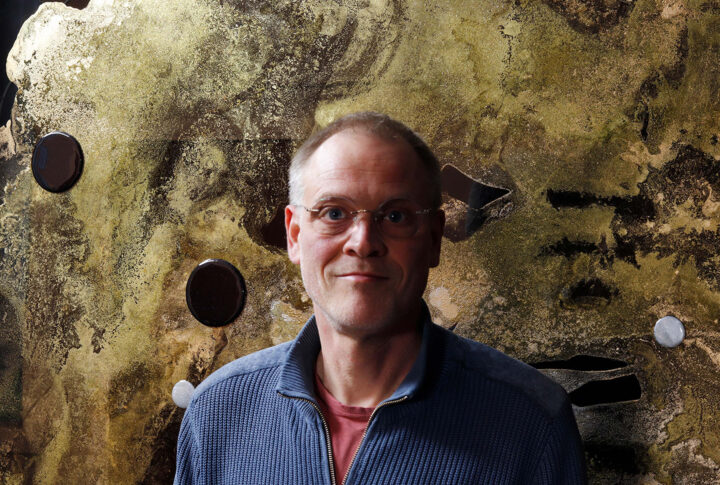
Stephan Konings is a Dutch visual artist whose paintings explore the threshold between seeing and meaning. Working from his studio in Amsterdam, he has developed a practice that treats the viewer as an active part of the work rather than a distant observer. His practice centers on painting as a form of cognitive investigation.
Each painting starts as an open field on an aluminium panel: layered metallic pigments build a dense, reflective ground that never fully settles into a fixed image. Across this field, Konings places coloured orbs made from interference mica pigments. As you move, they shift in hue and intensity; no two encounters look the same. What you see depends on angle, light and attention.
A central thread in his work is apophenia: the tendency to find patterns in ambiguous material. Konings uses this not as a flaw of perception but as a tool. His paintings are structured enough to suggest order, but never so explicit that the image fully closes. The viewer is pushed one step beyond certainty and becomes aware of their own pattern-seeking.
For Konings, beauty is “the suspicion of a hidden system”: the moment something feels coherent without revealing why. Once the organising principle is fully known, the enchantment breaks. His paintings stay deliberately before that point. They operate as locations where structure can be sensed but never fully used up.
Because Konings has aphantasia, he cannot form mental images and does not paint what he “sees in his mind”. Instead, he works from relations: weight, rhythm, proportion, reflection. The painting organises itself through the negotiation between hand, material and constraint. A final epoxy layer seals the surface, amplifying colour and light and inserting a reflective membrane between viewer and image.
Stephan Konings graduated from the Gerrit Rietveld Academie in Amsterdam in 1999. His work has been shown in solo and group exhibitions, is represented by Gallery 238 in Amsterdam, and is held in private collections in the Netherlands and abroad.
Artist statement
I do not work from images in my head. Because of aphantasia, inner pictures are simply not available to me. What remains is the underlying grammar: relations, tensions, alignments, breaks. I experience art as a field of forces rather than a window onto a scene.
My paintings are not illustrations of ideas I already have. Each work is a concentrated event in which material, rhythm and proportion temporarily fall into place. When that happens, it feels less like execution and more like discovery: the painting arrives before I fully understand it. The work is mine without having been pre-imagined by me.
I use two principles deliberately. First, apophenia: I stop before the image becomes obvious, so that any figure you see is something your own perception completes. Second, an apophatic stance toward depiction: I avoid explicit representation. What is present is structure. The central forms, the orbs, mark points of tension and relation, not fixed meanings.
Working without inner images, I am directly receptive to structural tensions in the material itself. Figuration, ordering and meaning are not planned but appear. Each painting is an encounter rather than a projection: a mirror field in which something of my own being becomes visible, unintended but inevitable.
Working principle: apophenic (the viewer infers patterns).
Stance toward depiction: apophatic (no explicit representation).
More information
Interview by Walter van Teeffelen:
marbellamarbella.es – World Fine Art Professionals and Their Key Pieces
Dutch version: inzaken.eu.
Music project:
Sonic Deaf Squad – (Bandcamp)
Artikel op Inzaken (Dutch)
inzaken.eu – Schoonheid is het vermoeden van een verborgen systeem